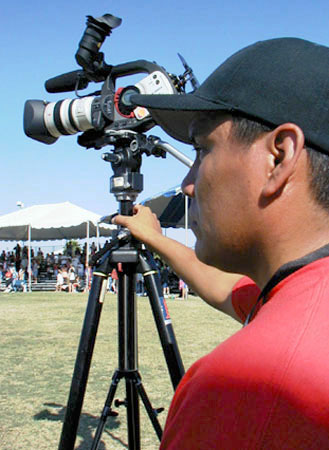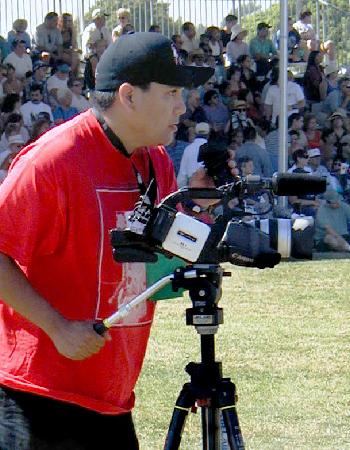|
|
Canku Ota |
|
|
(Many Paths) |
||
|
An Online Newsletter Celebrating Native America |
||
|
July 13, 2002 - Issue 65 |
||
|
|
||
|
Hollywood Diversity for the American Indian |
||
|
by Roscoe Pond, Actor
|
||
|
credits: photos
of Roscoe Pond by Suzanne Westerly, Photojournalist
|
|
I never gave a thought about diversity until
I began to go on auditions. Casting agents told me to let my hair down
and strip half naked before them. This is the image Hollywood has had
of American Indians for over 100 years. That had became tiring for me,
because it's not why I wanted to be an actor. So, two years later my
Agent encouraged me to cut off my long hair. It was the best thing I
ever did because I began to audition for other ethnic roles. My resume
had expanded. The Indian stereotype was something I had
to distance myself from. But, it is still there for other Indian men
in those auditions and it is evident that we have not come very far
in mainstream Hollywood. That image of "Savage warriors" and
"Indian maidens" still mirrors the modern Indian filmmaker. Hollywood did take notice of the American
Indian if only for a glimpse throughout the 1990's. Yet, it only encouraged
that image and did very little to change it. By the end of the decade
only Independent films became the voice for the modern Indian. "Dances with Wolves" (1990) opened
many doors for us whether we want to believe it or not. We became visible
to the world for the first time as a good decent race. That film won
seven Academy Awards and a place in history of Indians seen through
the eyes of a non-Indian. That same year Director David Lynch brought
"Twin Peaks" to ABC television and along with it came Indian
artist/actor Michael Horse. He was a regular and it was fun to watch.
Sadly, that show lasted only one TV season. Also, CBS television added a mid-season replacement
called "Northern Exposure" (1990). Set in Alaska but filmed
in the Northwest and Canada it had become a high rated TV show. It introduced
Elaine Miles to us as Marilyn Whirlwind. She was the only supporting
cast member who was Indian. She became an overnight TV celebrity. Yet,
over the years she has received a backlash because of her being over
weight. She had become a stigma for Indian women and the ever pressing
question "Are all Indian women obese"? "Northern Exposure" ran on CBS for an impressive 6 years (1990-95). It was seen around the world. Plus, it won seven Emmy awards including one for Best Drama in 1993. It also introduced modern Indian actor's as guest stars. It was a breath of fresh air and a positive outlook. From 1992 through 1997 Hollywood turned out
the stereotypical films that tried to be accurate towards Indian history:
"Thunderheart" (1992), "Last of the Mohicans" (1992),
"Geronimo" (1994) and "Pocahontas" (1995). On cable
television it got worse with TNT's own "Geronimo", "Crazy
Horse" and "Tecumseh". Let's not forget the terrible
"Stolen Women" on CBS. Through that period there were only several
productions that received rare critical acclaim. TNT's "Lakota
Woman" (1996) which starred Irene Bedard and garnered her a Golden
Globe nomination as best actress. I believe that it is a first for an
Indian woman. Then, there's the wonderful HBO drama "Grand Avenue"
(1996) starring Sheila Tousey which brought us urban city Indians and
their struggle in today's society. On film, "Maverick" (1995)
brought us a comedy performance by actor Graham Greene. It was the first
high profile film that gave an Indian actor a chance to have an equal
performance along side Mel Gibson. It was a box office winner and a
critical favorite.
With Independent films we have come a long
way with portraying American Indians positively. Today, Sundance has
premiered wonderful films including, "Christmas in the Clouds",
"The Doe Boy" and "Skins". Also, actor Eric Schweig
took a huge leap into the Gay film genre with "Big Eden".
It was very daring on his part which paid off and won him critical raves
and awards. Yet, Hollywood has not caught on to the modern
American Indian. Their main reason is Indians account for only 2% of
the nation's population. Therefore, who wants to see that fraction in
the big theater multiplexes across the country. It's a tough row to
hoe, because recently a high profile film called "Windtalkers"
is bombing at the box office. It has a big star in the name of Nicolas
Cage attached to it and Adam Beach. By Hollywood standards it just isn't
a money maker. We are trying to change in an industry that
is youth oriented and run by stereotypes. We are not alone either. African
Americans, Chinese, Japanese, Spanish and East Indians are fighting
the same battle. Diversity is opening it's doors though. NBC
and the Onieda Indian Nation produced an across America talent search
for comedians last year. The winners went to New York and performed
for NBC executives and casting agents. Producer Sonny Skyhawk and Dan
Jones also launched their Sky Dancer TV production company in 2001.
Their first project is called "The world of American Indian Dance".
Sonny has also begun a diversity campaign for American Indians by sitting
in on auditions for TV and Films as a consultant. He wants to be there
to ensure that Indians are portrayed correctly and not exploited. I
met him at an audition for ABC last spring. That was a reassuring plus.
The Southern California Indian Center in Los
Angeles is also launching a Multimedia program in partnership with Torres
Martinez Tribal TANF (Temporary assistance to needy families). First,
Actor Floyd Westerman and the Indian Center came up with the idea for
a training curriculum that would give Indians a chance to produce, write
and direct their own stories. What came out of these partnerships is
the EM2 2002 Entertainment Multimedia project. Classes will begin this
year and it is a hopeful start for Indian filmmaking. We still have a long way to go. The road to diversity for the American Indian in Hollywood is a battle that will continue long into the future. From Hollywood, Actor, Roscoe Pond
Roscoe didn't know about the help available for Native people, so he wants to let others know.
|
||||||||||||||
|
|
||
|
|
||
| Canku Ota is a free Newsletter celebrating Native America, its traditions and accomplishments . We do not provide subscriber or visitor names to anyone. Some articles presented in Canku Ota may contain copyright material. We have received appropriate permissions for republishing any articles. Material appearing here is distributed without profit or monetary gain to those who have expressed an interest. This is in accordance with Title 17 U.S.C. section 107. | ||
|
Canku Ota is a copyright © 2000, 2001, 2002 of Vicki Lockard and Paul Barry. |
||
 |
 |
|
|
The "Canku Ota - A Newsletter Celebrating Native America" web site and its design is the |
||
|
Copyright © 1999, 2000, 2001, 2002 of Paul C. Barry. |
||
|
All Rights Reserved. |
||
 I
came to Hollywood five years ago, in 1997, from Albuquerque, New Mexico.
It wasn't an easy thing to do and my path to California has been one
long struggle to make it, to be seen and heard.
I
came to Hollywood five years ago, in 1997, from Albuquerque, New Mexico.
It wasn't an easy thing to do and my path to California has been one
long struggle to make it, to be seen and heard. By
the end of the decade Independent films came to the forefront with "Smoke
Signals" (1998). It won critical raves coming out of the Sundance
Film Festival and became a box office hit. It was written, directed
and it starred an all Indian cast. That film kicked off a frenzy of
Independent productions that were made by Indians. Robert Redford went
as far as to support us by creating film workshops at Sundance in Utah.
By
the end of the decade Independent films came to the forefront with "Smoke
Signals" (1998). It won critical raves coming out of the Sundance
Film Festival and became a box office hit. It was written, directed
and it starred an all Indian cast. That film kicked off a frenzy of
Independent productions that were made by Indians. Robert Redford went
as far as to support us by creating film workshops at Sundance in Utah.